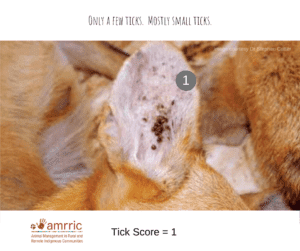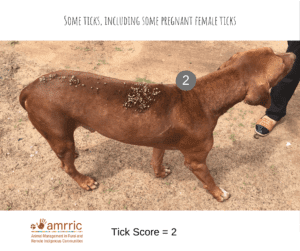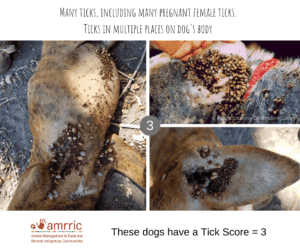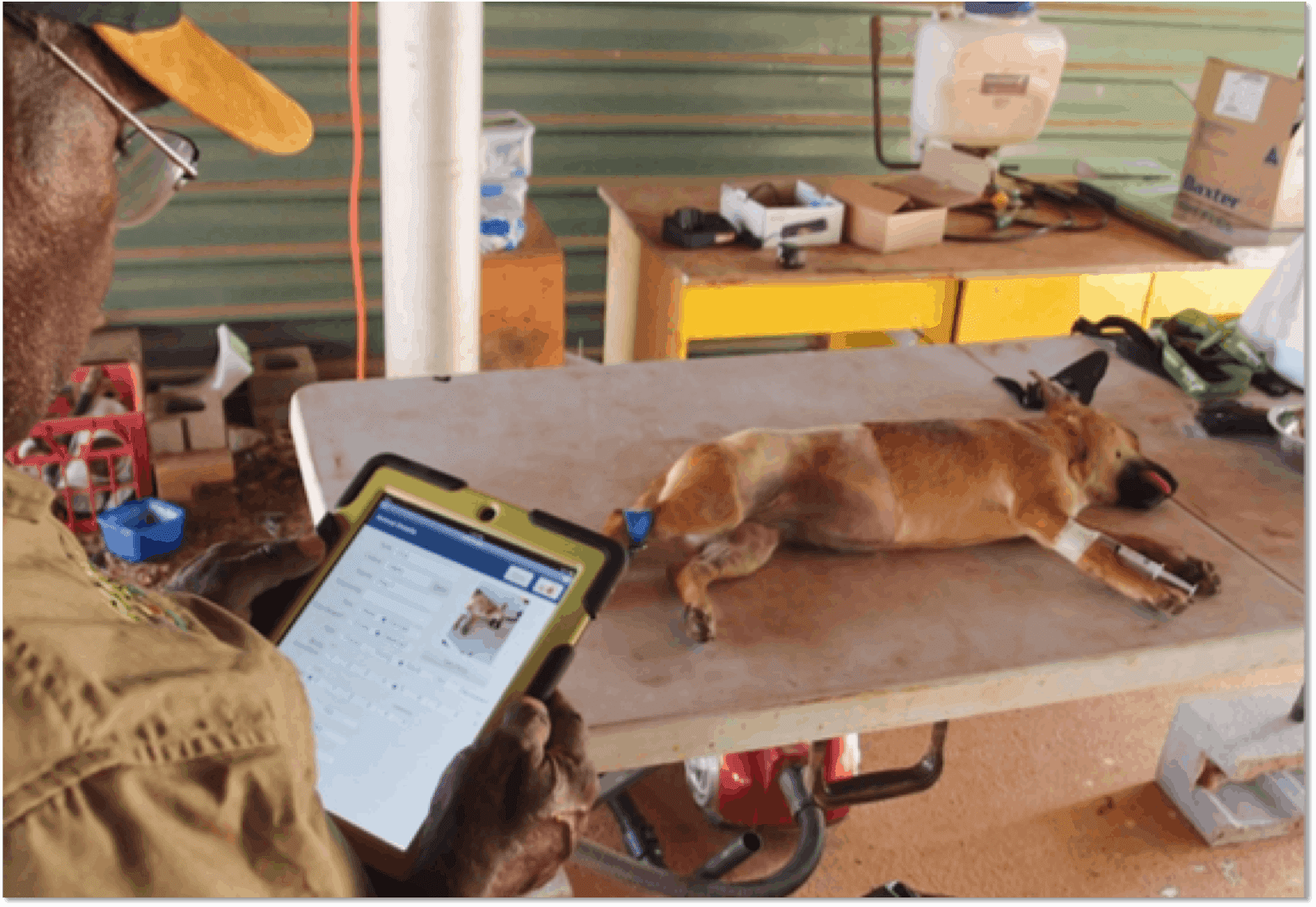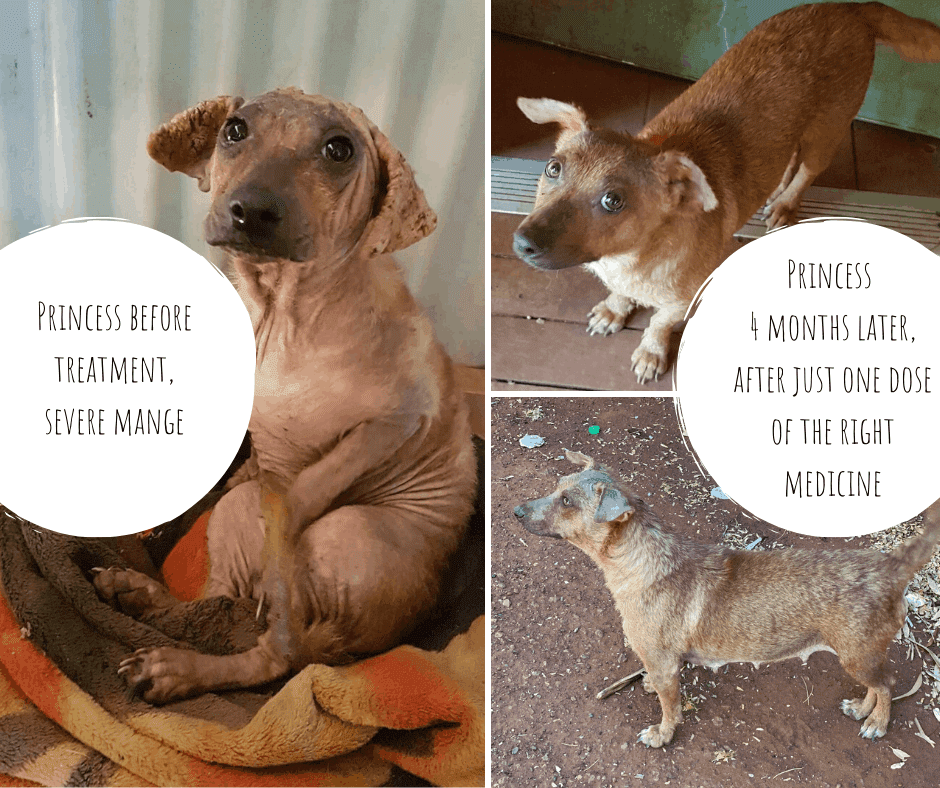CHAPTER EIGHTEEN
Record Keeping and Program Evaluation



Why keeping good records is important
Sometimes, record keeping can seem like a boring job, but keeping good records about the animal health and management program is actually really important.
There are lots of different records that you, as the EHP, can keep about the animal health and management program. There are also lots of different uses for these records.
Some of the records might be a legal requirement; others will help you to show the difference that the animal health and management program is making, and can help to get funding to keep the program running.
With good records, over time, you will know:
-
- how the health, numbers and behaviour of the dog and cat populations are changing
- what the animal health and management program costs, and what has been achieved for that money
If the animal health and management program is working well, over time, the records should show:
-
- improvements in animal health
- reductions in the number of problems with animals
- reductions in the number of complaints about animals
Good records can help your management and community to understand and support the program.
Ultimately, good records will:
-
- help with planning and scheduling
- help to meet legal requirements
- help to tell the story of the animal health and management program
- help keep the animal management program on track to achieving its goals
Tools used for record keeping
Records can be kept digitally (using an app or computer program) or on paper.
Some animal health and management programs will use a combination of digital and paper records.
There are pros and cons for each, but as technology gets better, digital records are becoming easier to use and let you do more with the information you are recording.
They also save you time by automatically making reports and summaries of the records entered.
The AMRRIC App
AMRRIC has made an app that makes it easy to keep good records for remote community animal health and management programs.
The app is a tool that can be used without an internet connection and lets the EHP team record lots of things, including:
-
- the number and type of animals at each household
- identification details for each animal (e.g. photos of the animal, microchip numbers, registration numbers)
- the gender, reproductive status and age of each animal
- the health of each animal, and any problems they might have
- treatments given to each animal
- jobs that the vet or EHP needs to follow up on
- complaints about each animal
- contact details for each animal’s owner
The app can automatically make reports about a range of things, including:
-
- the total numbers and types of animals in a community or council area
- the number and proportion of animals that are desexed
- the health of the animals in the community
- the numbers and types of treatments that have been given over a certain time period
- a job list for the vet or EHP
These reports can then be emailed to anyone, including managers, council or another member of the EHP team.
AMRRIC is always updating and adding new features to The AMRRIC App.
Talk to AMRRIC about whether or not the AMRRIC App would suit your animal health and management program.
Paper and digital forms
Paper or digital forms can be used to record animal health and management information.
AMRRIC has some example forms in their resources library.
These can be downloaded and adapted to suit your animal health and management program.
They can be printed and used as paper forms, or used digitally (accessed on a phone, tablet or computer).
If your work has IT staff, they might be able to help you set up a digital system for these forms.
Medicines books
If you are authorised to use Schedule 4 (S4) medicines, your state or territory Department of Health might ask you to keep a medicines book.
Each medicine that you are authorised to give gets its own section in a medicines book.
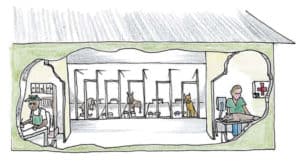
For each different type of medicine, you might be asked to record:
-
- the date it is given
- details about the animal it was given to
– the animal’s name, age, gender and reproductive status
– the owner’s name and address
– why the animal was given the medicine - how much medicine the animal received
- how much medicine is left in the bottle after each dose is given
When it is not in use, this book is usually stored in the locked container, with the S4 medicines.
Sometimes, EHOs or other staff from the Department of Health might ask to check your book, and make sure that the records match the amount of medicines in the container.
See Chapter 2 for more information about authorisations for S4 medicines.
When to start keeping records
When an animal health and management program is first started, the health of animals can improve very quickly.
So that you can show the changes the animal health and management program has made, it is important to keep good records right from the very start of the program.
You might hear people talking about doing a ‘baseline census’. This just means that they are getting animal health and management records at the starting point for the animal health and management program.
Once the animal health and management program is running, the baseline census can be compared to future records, to see what changes the program has caused over time.
Program monitoring and program evaluation
‘Program monitoring’ and ‘program evaluation’ are just ways of talking about assessing records, to see if a program is working as planned.
Monitoring is like satellite navigation for an animal health and management program; if the program takes a wrong turn, monitoring will help you to realise, and redirect the program, so it can get back on track to achieve its goals.
Just like a satellite navigation always tracks your location, program monitoring is something that should be done continuously.
Evaluation is more like a performance review for the animal health and management program. It is something that is usually done once every year or two, and usually involves everyone who has been involved with the program, including you (the EHP), the vet, management and representatives of the community. If the program has external funding, the program funders might also want to be involved.
An evaluation lets everyone talk about what is working well, what should be changed or improved, and whether or not the program’s goals have been met. The evaluation’s discussions are usually turned into a formal report which can be used to help find future funding for the program.
AMRRIC can help councils to monitor and evaluate their animal health and management programs. Talk to AMRRIC if you want to find out more about animal health and management program monitoring and evaluation.
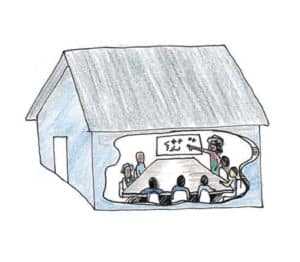
Animal health and management program indicators
When people talk about ‘indicators’ as part of program monitoring and evaluation, they are talking are talking about the things that can be measured and recorded, that show how a program is working.
There are many different indicators that can be used to show if an animal health and management program is working.
At the start of the animal health and management program, it is a good idea to work out which indicators will work best for your community, and what method will be used to measure each indicator. Using the same method of measuring each indicator every time the information is collected, means that each indicator can be compared over time, and between communities.
Indicators can be about each animal. Things like:
-
- the numbers of dogs and cats at each house
- the age category of each animal
- each animal’s gender and reproductive status
- body condition, skin condition and tick burden scores for each animal
- other health problems that animals have
Indicators might also measure things about people, like:
-
- the number of dog bites reported to the health clinic
- the number of zoonotic diseases diagnosed in people, that might have come from their pets
- the number and type of complaints made to the EHP by community members, about problems caused by animals
- people’s opinions of the animal health and management program
If the right indicators are consistently measured and recorded, evaluation of the records over time is easy. This will also make it easier to tell if the animal health and management program is achieving its goals.
AMRRIC can help you to choose indicators, to monitor and evaluate your animal health and management program. Contact AMRRIC for advice.

Scoring systems to help measure animal health indicators
On the AMRRIC App and census forms, scores can be used to show how healthy an animal is.
Scoring animal health indicators allows for easier comparison between animals, and over time, helps to show what improvements the animal health and management program is making.
Scoring is mostly used to measure body condition, skin condition, and ticks. A description of each of these scores is below, or you can download a pictorial guide to body conditions scores, skin scores and tick scores here.
Body condition scores
Body condition scores are used to show how thin or fat an animal is.
Animals are given a score from 1 to 9, where 1 is very thin and 9 is very fat. Animals that are in good body condition will have a body score of 5.
Sometimes, instead of numbers, a simplified body condition score system might be used, where the choices are ‘thin’, ‘good’ or ‘fat’. On the 1-9 scale:
-
- ‘thin’ matches to a score of between 1 and 3,
- ‘good’ matches to a score of between 4 and 6, and
- ‘fat’ matches to a score of between 7 and 9.
If animals are too skinny, they will have a weak immune system. These animals get sick more easily and put more germs into the environment.
If animals are too fat, they can have health problems like heart disease and arthritis.
The best score for an animal is 5. These animals are fit and healthy.
Use the pictures below as a guide to help you with giving body condition scores to dogs. When you are treating dogs together, you can also check with your vet to see if your body condition scores match theirs.



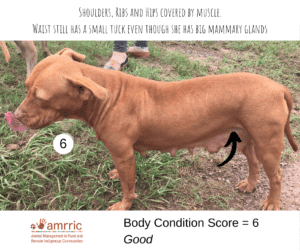


Skin scores
Skin problems that cause hair loss are usually scored using a scale from 0 to 5, where 0 is no skin problem and 5 is very bad hair loss and skin crusting.
In most remote communities, skin problems in dogs are usually caused by fungal problems or mange. See Chapter 6 for more information about common skin problems in dogs.
Ideally, all animals would have healthy hair and skin, and so would have a skin score of 0.
Sometimes instead of numbers, a simplified skin score might be used, where the options are ‘good hair’, ‘some hair loss’ or ‘no hair’). When a simplified score is used, they match the numbers like this:
-
- Skin score 0 = ‘good hair’
- Skin scores 1-3 = ‘some hair loss’
- Skin scores 4 or 5 = ‘no hair’
Use the pictures below as a guide to help you with giving skin scores to dogs. When you are treating dogs together, you can also check with your vet to see if your skin scores match theirs.
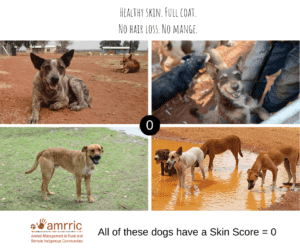
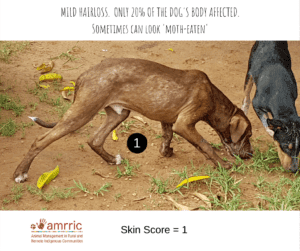
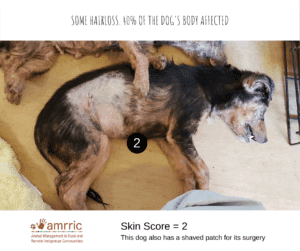
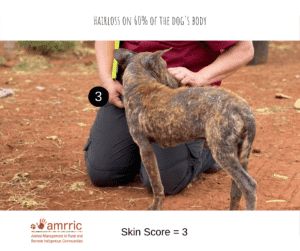
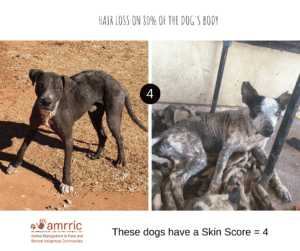
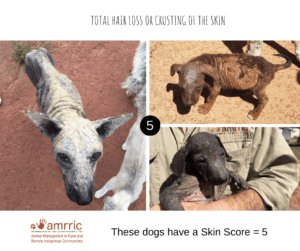
Tick scores
Ticks can be scored using a 0 to 3 scoring system, where 0 is no ticks and 3 is a very bad tick problem.
Ideally, all animals would get regular anti-parasite treatments, and so would have no ticks, and so a tick score of 0.
Use the pictures below as a guide to help you with giving tick scores to dogs. When you are treating dogs together, you can also check with your vet to see if your tick scores match theirs.
